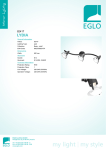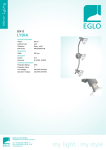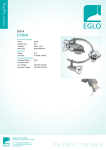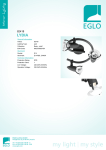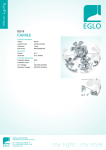Download Hampton Bay 34002 Installation Guide
Transcript
Hampton Bay Lifetime Motor Warranty
Date Purchased
The retailer warrants the fan motor to be free from defects in workmanship and material
present at time of shipment from the factory for a lifetime after the date of purchase by the
original purchaser. The retailer also warrants that all other fan parts, excluding any glass or
plexiglass parts, to be free from defects in workmanship and material at the time of shipment
from the factory for a period of one year after the date of purchase by the original purchaser.
We agree to correct such defects without charge or at our option replace with a comparable or
superior model if the product is returned to the retailer. To obtain warranty service, you must
present a copy of the receipt as proof of purchase. All costs of removing and reinstalling the
product are your responsibility. Damage to any part such as by accident or misuse or
improper installation or by affixing any accessories, is not covered by this warranty.
Because of varying climatic conditions in the United States this warranty does not cover any
changes in brass finish, including rusting, pitting, corroding, tarnishing or peeling. Brass
finishes of this type give their longest useful life when protected from varying weather
conditions. A certain amount of wobble is normal and should not be considered a defect.
Servicing performed by unauthorized persons shall render the warranty invalid. There is no
other express warranty. The retailer hereby disclaims any and all warranties,
including but not limited to. Those of merchantability and fitness for a particular
purpose to the extent permitted by law. The duration of any implied warranty which
cannot be disclaimed is limited to the time period as specified in the express warranty. Some
states do not allow limitation on how long an implied warranty lasts, so the above limitation
may not apply to you. The retailer shall not be liable for incidental, consequential, or
special damages arising out of or in connection with product use or performance except
as may otherwise be accorded by law. Some states do not allow the exclusion of incidental
or consequential damages, so the above exclusion or limitation may not apply to you. This
warranty gives specific legal rights, and you may also have other rights which vary from
state to state. This warranty supersedes all prior warranties.
Store Purchased
Model No.
193-978
Serial No.
Vendor No.
UPC
219054
718212340028
Lifetime Motor Warranty
SAFETY RULES.................................................................................................... 1
PACKAGE CONTENTS ........................................................................................ 2
INSTALLING YOUR FAN..................................................................................... 3
ASSEMBLING YOUR FAN................................................................................... 4
HANGING THE FAN............................................................................................. 5
ELECTRICAL CONNECTIONS .......................................................................... 6
FINISHING THE INSTALLATION....................................................................... 7
BLADE INSTALLATION ..................................................................................... 8
INSTALLING THE LIGHT KIT & GLASS SHADE.............................................. 9
OPERATING THE TRANSMITTER................................................................. 10
CARE OF YOUR FAN.......................................................................................... 11
TROUBLESHOOTING........................................................................................ 12
SPECIFICATIONS...............................................................................................13
Table of Contents
1.
Before you begin installing the fan, shut power off at the
circuit breaker or the fuse box.
2.
Be cautious! Read all instructions and safety information
before installing your new fan. Review accompanying
assembly diagrams.
3.
4.
Make sure that all electrical connections comply with local
codes, ordinances, or National Electrical Codes. Hire a
qualified electrician or consult a do-it-yourself wiring
handbook if you are unfamiliar with installing electrical
wiring.
Make sure the installation site you choose allows the fan
blades to rotate without any obstructions. Allow a minimum
clearance of 7 feet from the floor and 18 inches from the tip
of the blades to the wall.
9.
Do not insert anything into the fan blades while the fan is operating.
10. Turn the fan off and wait for it to stop completely before changing the
fan direction.
ATTENTION: The Energy Policy Act of 2005 requires this fan to be
equipped with a 190 watt limiting device. If lamping exceeds 190
watts, the ceiling fan's light kit will shut off automatically.
NOTE: The important safeguards and instructions appearing in this
manual are not meant to cover all possible conditions and situations that
may occur. It must be understood that common sense, caution and care are
factors which can not be built into this product. These factors must be
supplied by the person(s) installing, caring for and operating the unit.
NOTE
READ AND SAVE ALL INSTRUCTIONS!
5.
If you are mounting the fan to a ceiling outlet box, use U.L.
Listed metal octagonal outlet box marked "Acceptable for
fan support". Secure the box directly to the building
structure. The outlet box and its support must be able to
support the moving weight of the fan (at least 50 lbs.) Do
not use a plastic box.
6.
Caution: To reduce the risk of personal injury use only the
screws provided with the outlet box.
7.
If you are mounting the fan to a joist, make sure it is able to
support the moving weight of the fan (at least 50 lbs.).
8.
After you install the fan, make sure that all mountings are
secured to prevent the fan from falling.
1. Safety Rules
WARNING
TO REDUCE THE RISK OF FIRE, ELECTRIC SHOCK, OR OTHER PERSONAL
INJURY, MOUNT FAN ONLY TO A U.L. LISTED OUTLET BOX OR SUPPORTING
SYSTEM MARKED ACCEPTABLE FOR FAN SUPPORT AND USE MOUNTING
SCREWS AND LOCK WASHERS PROVIDED WITH THE OUTLET BOX, MOST
OUTLET BOXES COMMONLY USED FOR THE SUPPORT OF LIGHTING
FIXTURES ARE NOT ACCEPTABLE FOR FAN SUPPORT AND NEED TO BE
REPLACED. CONSULT A QUALIFIED ELECTRICIAN IF IN DOUBT.
TO REDUCE THE RISK OF PERSONAL INJURY, DO NOT BEND THE BLADE
HOLDERS WHILE INSTALLING, BALANCING THE BLADES, OR CLEANING
THE FAN. DO NOT INSERT FOREIGN OBJECTS BETWEEN ROTATING FAN
BLADES.
TO REDUCE THE RISK OF FIRE OR ELECTRIC SHOCK, DO NOT USE THIS FAN
WITH ANY SOLID-STATE SPEED CONTROL DEVICE
2
UP LIGHT
6
10
7
11
LO
MED
HI
FAN OFF
DOWN LIGHT
14
1
3
4
5a
15
8
a
b
12
9
13
5b
16
c
Unpack your fan and check the contents. You should have the following items:
1. Fan blades (5 )
2. Hanger bracket
3. Canopy
4. Canopy cover
5a. Standard downrod assembly
5b. Minimum-length downrod (for close to
ceiling mounting only)
6. Coupling cover
7. Upper housing
8. Bulb holder assembly
9.
10.
11.
12.
13.
14.
Fan motor/housing assembly
Blade holders (5)
40W candelabra bulbs (3)
Glass shade
Light kit stem
Remote control with hand
held and 2 mounting screws
15. Receiver with 7 wire nuts
16. Balancing kit
a. Mounting Hardware:
Wire nuts (3 PCs.)
b. Blade Attachment Hardware:
Screws (16 PCs.)
Fiber washers (16 PCs.)
c. Blade Holder Hardware:
Screws with lock washers (11 PCs.)
Package Contents 2.
Tools Required
Phillips screw driver; slotted screw driver; stepladder; wire cutters; electrical tape.
Ceiling
joist
Angled ceiling
maximum
17 angle
Provide strong
support
Cross brace
Mounting Options
If there isn't an existing mounting box, then read the
following instructions. Disconnect the power by
removing fuses or turning off circuit breakers.
Secure the outlet box directly to the building
structure. Use appropriate fasteners and building
materials. The outlet box and its support must be
able to fully support the moving weight of the fan
(at least 50 lbs.). Use a UL Listed metal outlet box.
Do not use a plastic outlet box.
Outlet box
Recessed
outlet box
Hanger
opening must
be facing up-side
Ceiling
joist
Figure 3
Figure 1
Ceiling joist
or cross brace
Parallel
wood brace
Hanger bar
(optional)
Ceiling
joist
Figure 1, 2 and 3 are examples of different ways to
mount the outlet box.
Note: You may need a longer downrod to maintain
proper blade clearance when installing on a steep,
sloped ceiling. Longer downrods are available from
your Hampton Bay dealer.
To hang your fan where there is an existing fixture
but no ceiling joist, you may need to install a hanger
bar as shown in Fig. 4 (available at your Hampton
Bay dealer).
Outlet box
Outlet box
Figure 2
3. Installing Your Fan
Figure 4
Hanger
bracket
Your fan is packed with the motor and Upper
Housing unassembled, proceed the following
steps for fan assembly:
Step1. Remove the two screws and rubber
washers from the top of the motor center band.
Place the upper housing over the motor center
band and secure it with the two screwsand
rubber washers previously removed.(Fig.5)
Step2. Engage the white wire connectors
from the motor and the bulb holder assembly
make sure the connection is secured Follow
the same procedure for the orange and black
wire connectors.(Fig.6)
Screw
Upper housing
Rubber
washers
Bulb holder
assembly
Screws
Motor
Motor
coupling
Top motor
Motor
center
band
Figure 7
Figure 5
Step3. Loosen the three screws (do not
remove) from the motor coupling.(Fig. 7)
Step4. Place the bulb holder assembly key
holes over the 3 screws previously loosened
from the motor coupling, turn the bulb holder
assembly until it locks in place at the narrow
section of the key holes. secure by tightening
the three screws previously loosened.(Fig.7)
Bulb holder
assembly
Wire
connectors
Motor
Figure 6
Assembling your fan 4.
REMEMBER to turn off the power. Follow Step 6. Now lift motor assembly into position
and place hanger ball into hanger bracket.
the steps below to hang your fan properly:
Rotate until the check groove has dropped
Step 1. Secure the hanger bracket to the into the registration slot and seats firmly. (Fig.
ceiling outlet box using screws included 13) Rod should not rotate if this is done
with your outlet box, lock washers correctly.
included with the fan. (Fig.8)
Outlet box
Step 2. Loosen the two set screws and
remove the hitch pin and lock pin in the top
coupling of the motor assembly. (Fig. 9)
Step 3. Remove hanger ball from downrod
a s s e m b l y b y l o o s e n i n g s e t s c r e w,
removing the cross pin, and sliding ball off
rod. (Fig.10)
Hitch
pin
Step 5. Slip coupling cover, canopy cover
and canopy onto downrod. (Fig. 12)
Carefully reinstall hanger ball onto rod
being sure that cross pin is in correct
position, set screws are tighten and wires
are not twisted.
Coupling cover
*Omit coupling
cover when using
the minimum-length
downrod
Lock
pin
Canopy
Canopy cover
Set screws
Hanger bracket
Hitch pin
Figure 8
Step 4. Carefully feed fan wires up
through the downrod. (Fig. 11) Thread the
rod into the coupling. Next line up holes
and replace lock pin and hitch pin. Tighten
set screws.
Set
screws
Downrod
Figure 9
Figure 12
Cross pin
Downrod
Hanger
ball
Screw
Downrod
Figure 10
5.Hanging the Fan
Supply
wires
Figure 11
Registration
slot
Figure 13
Lock pin
WARNING: To avoid possible electrical
shock be sure electricity is turned off at the
main fuse or breaker box before wiring.
NOTE: The Hand Held Remote or Wall
Control units included with your ceiling fan
are equipped with 16 code combinations to
prevent possible interference from or to other
remote units. The frequency switches on your
Receiver and Transmitter units have been
preset at the factory, please re-check to make
sure the switches on both units are set to the
same positions. The frequency settings should
be changed only in case of interference or if a
second or more remote controlled ceiling fans
are installed in the same structure. Any code
combination will operate the ceiling fan and
light as long as the Receiver and Transmitter
units are set to the same codes (Fig. 14)
Step 1. Insert Receiver into Hanger Bracket
with the flat side of the Receiver facing the
ceiling. (Fig. 15)
Step 2. Motor to Receiver Electrical
Connections: Connect the WHITE wire from
the fan to the WHITE wire marked "TO
MOTOR N" from the Receiver. Connect the
BLACK wire from the fan to the BLACK Wire
marked "TO MOTOR L" from the Receiver.
Connect the BLUE wire from the fan to the Note: The transmitter only works within 40
BLUE wire marked "For Light" from the feet from receiver.
Receiver. NOTE: If your ceiling fan features
an UP Light: Connect the ORANGE wire
from the fan to the ORANGE wire marked
"For Up Light" from the Receiver. Otherwise
disregard this step and proceed to secure all
wire connections with the plastic wire nuts
provided. (Fig. 16 )
Step 3. Receiver to House Supply Wires
Electrical Connections: Connect the WHITE
wire (Neutral) from the outlet box to the
WHITE wire marked "AC in N" from the
receiver. Connect the BLACK wire (Hot)
from the outlet box to the BLACK wire
marked "AC in L" from the receiver. Secure
all wire connections with the plastic wire
nuts provided. (Fig. 16 )
ON
Figure 14
Receiver
Step 4. If your outlet box has a GROUND
wire (Green or Bare Copper) connect this
wire to the Hanger Ball and Hanger Bracket
Ground wires. If your outlet box does not
have a Ground Wire, then connect the
Hanger Ball and Hanger Bracket Ground
Wires together. Secure wire connection with
the plastic wire nut provided. (Fig. 16 )
After all connectors are made, check to make
sure there are no loose strands. As an
additional precaution we suggest to secure
the plastic wire connectors to the wires with
electrical tape.
Hanger bracket
Figure 15
Electrical Connections 6.
Step 1. Tuck connections neatly into ceiling
outlet box.
Outlet box
Black (hot)
Black ("AC IN L")
White (neutral)
Green or bare
copper (ground)
White ("AC IN N")
Receiver
Black ("to motor L")
Blue (for bottom light)
Orange
(for upper light)
Blue (for bottom light)
Black (motor)
Orange
(for upper light)
White ("to motor N")
Step 2. Slide the canopy up to ceiling and
over the two crews on hanger bracket. Rotate
canopy clockwise. Next, while holding the
canopy with one hand, slide the canopy cover
over the screws and rotate clockwise until
tight. Note: adjust the canopy screws as
necessary until the canopy and canopy cover
are snug. (Fig. 17)
Outlet box
Hanger
bracket
Hanger
ball
Canopy
Ground (Connect to
(green) ground wire on
hanger bracket
if no house
ground wire
exists.)
White (neutral)
Fan
Figure 16
7. Finishing the Installation
Figure 17
Canopy
cover
Step 2. Raise the glass shade up against
the light plate and secure it to the fan with
the light kit stem. (Fig. 20)
8. Blade Installation
Step1. Attach the fan blade to the blade
holder using the screws and fiber washers
provided. Tighten screws securely. Repeat
process for remaining blades.(Fig. 18)
Step2. Rotate motor until holes become
visible through the light plate access window.
Align the holes from the blade holder to the
holes from the motor and secure in place with
screws provided (Fig. 19)
Fiber
washers
Screws
Blade holder
Light plate
Access
window
Blade
holder screw
Figure 19
9. Installing the Light
Bulb & Glass Shade
Light plate
Blade
Figure 18
Blade
holder
REMEMBER: To disconnect the power.
The fan blades must be already attached to
the fan.
ATTENTION: The Energy Policy Act of
2005 requires this fan to be equipped with a
190 watt limiting device. If lamping
exceeds 190 watts, the ceiling fan's light kit
will shut off automatically.
Step 1. Install 3x40w bulbs (included).
(Fig. 20)
40 W candelabra bulb
Bulb
socket
Light kit stem
Glass shade
Light kit stem
Figure 20
Restore power to ceiling fan and test for
proper operation.
Install 9 volt battery (not included), to
prevent damage to transmitter, remove the
battery if not used for long periods. (Fig. 21)
A. HI, MED, and LOW buttons:
These three buttons are used to set the fan
speed as follows:
HI= high speed
Med= medium speed
Low= low speed
The Reverse switch is located on top of the
motor assembly. Slide the switch to the Left
for warm weather operation. Slide the switch
to the Right for cool weather operation.
B. FAN OFF button:
This button turns the fan off.
NOTE: Wait for fan to stop before changing
the setting of the slide switch.
C.
DOWN LIGHT button:
This button controls the downlight.
D.
UP LIGHT button:
This button controls the uplight.
Warm weather - (Forward) A downward air
flow creates a cooling effect as shown in
Figure 23. This allows you to set your air
conditioner on a higher setting without
affecting your comfort.
9V
Ba olt
tte
ry
Installing the battery:
Figure 21
Press and release the button to turn the light
ON or OFF. Press and hold the button to set
the desired brightness. The light key has an
auto-resume, it will stay at the same
brightness as the last time it was turned off.
Speed settings for warm or cool weather
depend on factors such as the room size,
ceiling height, number of fans, etc.
Cool weather - (Reverse) An upward airflow
moves warm air off the ceiling area as shown
in Figure 24. This allows you to set your
heating unit on a lower setting without
affecting your comfort.
UP LIGHT
LO
MED
HI
FAN OFF
DOWN LIGHT
Figure 22
10.Operating the Transmitter
Figure 23
Here are some suggestions to help you
maintain your fan
5. There is no need to oil your fan. The
motor has permanently lubricated bearings.
1.Because of the fan's natural movement,
some connections may become loose. Check
the support connections, brackets, and blade
attachments twice a year. Make sure they are
secure. (It is not necessary to remove fan
from ceiling.)
6. All glass should be cleaned using
lukewarm soapy water and a soft cloth or
sponge.
2. Clean your fan periodically to help
maintain its new appearance over the years.
Use only a soft brush or lint-free cloth to
avoid scratching the finish. The plating is
sealed with a lacquer to minimize
discoloration or tarnishing. Do not use water
when cleaning. This could damage the motor,
or the wood, or possibly cause an electrical
shock.
3. Use only a soft brush or lint-free cloth to
avoid scratching the finish. The plating is
sealed with a lacquer to minimize
discoloration or tarnishing.
DO NOT IMMERSE GLASS IN HOT
WATER. DO NOT PUT GLASS INTO AN
AUTOMATIC DISHWASHER.
WARNING: Make sure the power is off
at the electrical panel box Before you
attempt any repairs. Refer to the section,
"Making Electrical Connections".
For any additional information on your
Hampton Bay Ceiling Fan, please write to:
THE HAMPTON BAY FAN & LIGHTING CO.
P. O. Box 395
Norco, CA 92860
Figure 24
4. You can apply a light coat of furniture
polish to the wood blades for additional
protection and enhanced beauty. Cover small
scratches with a light application of shoe
polish.
Call toll free 1-800-527-0998
Care of Your Fan 11.
Problem
Solution
Fan will not start.
1. Check circuit fuses or breakers.
2. Check line wire connections to the fan and switch wire connections in the switch housing.
CAUTION: Make sure main power is off.
3. Check to make sure the dip switches from the transmitter and receiver are set to the same frequency.
Fan sounds noisy.
1. Make sure all motor housing screws are snug.
2. Make sure the screws that attach the fan blade bracket to the motor hub is tight.
3. Make sure wire nut connections are not rubbing against each other or the interior wall of the switch housing.
CAUTION: Make sure main power is off.
4. Allow a 24-hour "breaking-in" period. Most noise associated with a new fan disappear during this time.
5. If using an optional light kit, make sure the screws securing the glassware are tight. Check that the light bulb
is also secure.
6. Do not connect the fan with a wall mounted variable speed control (s)
7. Make sure the upper canopy is a short distance from the ceiling. It should not touch the ceiling.
Remote control
malfunction.
1. Do not connect the fan with a wall mounted variable speed control (s).
2. Check to make sure the dip switches from the transmitter and receiver are set to the same frequency.
Lights shut off and will
not come back on.
1. This unit is equipped with a wattage limiting device. Lamping in excess of 190 watts will disable your ceiling
fan's light kit. To reset your light kit you must turn the power off and re lamp, keeping the wattage under 190
watts. Restore power to your ceiling fan and continue normal operation.
Fan Wobble.
NOTE: All blade sets are grouped by weight. Because wood and plastic blades vary in density, the fan
may wobble even though blades are matched.
1. Make sure all blade attachment screws are tight.
2. Make sure Outlet box is secured to building structure, if necessary use the wood screws provided to
further secure outlet box to joist.
3. Make sure Hanger Bracket is secure to the outlet box, screws are tight.
4. Use the balancing kit provided if the wobble is excessive (follow instructions included with balancing kit)
12. Troubleshooting
Fan Size
52"
Speed
Volts
Amps
Watts
RPM
CFM
Low
120
0.33
15
65
1030
Medium
120
0.40
30
105
3850
High
120
0.50
60
160
5175
N.W.
G.W.
11.96 kgs 13.44 kgs
C.F.
2.64'
(26.34 lbs) (29.59 lbs)
These are typical readings. Your actual fan may vary. They do not include Amps and Wattage used by the light kit.
Distributed by
Home Depot U.S.A., Inc.
2455 Paces Ferry Rd., N.W.
Atlanta, GA 30339
Specifications 13.




























